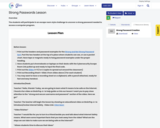
Exercising Patterns Mathematics Instructional Plan
- Subject:
- Mathematics
- Material Type:
- Lesson Plan
- Provider:
- VDOE
- Author:
- VDOE
- Date Added:
- 10/04/2024

Exercising Patterns Mathematics Instructional Plan

How Many Tables Task Template and Student Version of Task

The students will collaboratively create a dance using the Dance Party Hour of Code Activity.

Identifying, creating, extending, and transferring repeating and growing patternsMathematics Instructional Plans (MIPs) help teachers align instruction with the 2016 Mathematics Standards of Learning (SOL) by providing examples of how the knowledge, skills and processes found in the SOL and curriculum framework can be presented to students in the classroom.

A Visual Arts Activity Inspired by Works of Art from the VMFA Collection
Cultures all over the world create decorative patterns, perhaps inspired by the enduring patterns humans see in the natural world that surrounds us, from the cycle of the seasons to the pattern of the stars in the heavens. These hands-on activities, which can be adapted for a number of grade and ability levels, introduce repeating and alternating patterns, as well as the concept of a visual motif.

Teach about the Fibonacci sequence being a series of numbers and which is found reflected in nature. Students create artwork based on the sequence.

Set students up for programming success by creating a BeeBot anchor chart!These editable instructions will help students identify their role as planner or driver and set clear expectations of how Bee-Bot is used in computer programming. Tips:Introduce Bee-Bot whole classMake sure students understand the importance of the clear (x) button to erase the previous codealways press clear first to signal a new code (like how a capital letter signals the start of a new sentence) Plan the program in developmentally appropriate steps (some students program one step at a time, while others can program to the end goal)Turn the Bee-Bot off and use it as a game piece to write successful algorithmsHave students write their plan, or algorithm, on a whiteboard instead of using the cardsThe Bee-Bot emulator is perfect for guided practice!

Just in Time Quick Check Patterns

This lesson uses loops to connect to the math SOL 2.16 (Patterns).

The students will participate in an escape room style challenge to uncover a strong password needed to access a computer program.

This lesson connects the invention of the x-ray by Tesla to the artwork of Austrailian Aboriginals.